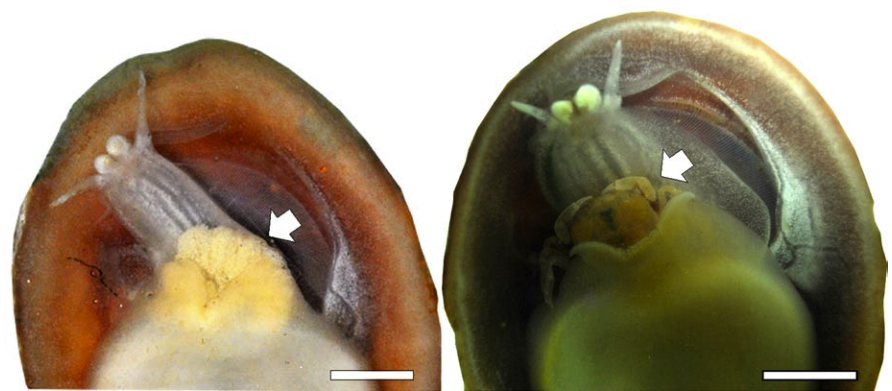 |
| Limpet without (left) and with (right) C. garthi Image from Fig. 2 of the paper |
Pea crabs are tiny crabs that specialise in making a living inside the body of marine invertebrates like various molluscs and echinoderms. The species featured in the study we are looking at today is Calyptraeotheres garthi, which lives inside limpets on the coast of Argentina. The researchers that conducted this study started noticing that most limpets that have crabs tend not to produce any egg sacs during the reproductive seasons, so they tried to find why that is by examining limpets from the field and by raising both crab-free and crab-infected limpets in the lab to compare their reproductive output.
Out in the wild, about a third of the crab-free limpets carried eggs during the breeding season, and a few of the limpets infected with smaller male or juvenile crabs managed to produce at least some eggs. But the limpets that were harbouring fully-mature female crabs had no eggs at all. This was similar to what they observed in their captive limpet population - while half of the uninfected limpets could spawn and produce a brood, none of the crab-laden limpets managed to do so.
Even though the crab-infected limpets did not produce any eggs, they had intact ovaries which were filled with oocytes (egg cells) ready to go. And when the researchers they remove crabs from infected limpets, they quickly recovered. Within a week or two after crab removal, those limpets started producing eggs again. So how was C. garthi stopping the limpet from producing a brood? Is the crab hogging all the nutrients and leave none to the developing eggs?
These limpets feed by collecting phytoplankton (floating, single-celled algae) into a mucus string around the gill fringe, and that is what C. garthi feeds on - pilfered strings of algae-loaded slime from its host. While you might think this free-loading would be taking a major toll on the limpets, they do not seem to be too affected by this. Crab-infected limpets carried on feeding and digesting at the same rate as crab-free ones, so the little crustaceans was not affecting the limpet's usual energy intake - at least not to a level that the host cannot compensate.
 |
| Calyptraeotheres garthi with a stomach full of phytoplankton Image from Fig. 4 of the paper |
Despite not being a severe physiological drain, their physical presence occupy the spot where the limpet would carry its brood of eggs. So while the limpet can still carry on feeding and digesting as normal, it gets brood-blocked by the crab.
The relationship between the limpet and the crab is made even more complicated by seasonal changes. During summer, the larger limpets that are infected with C. garthi are healthier than crab-free limpets, but in winter the situation is reversed. However, on top of that, during winter, only the larger limpets with crabs suffer a decline in health, while those below a certain size threshold gets away with carrying around a food-stealing crab without any severe consequences.
From our perspective, under certain circumstances, it might actually seem beneficial to have a pea crab, seeing as crab-harbouring limpets seems to be healthier during certain times of year. But from an evolutionary perspective, this pea crab is extremely harmful - by preventing its host from reproducing, it is effectively terminating that individual limpet's genetic lineage - all just for a mouthful of green slime.
Reference:
Ocampo, E. H., Nuñez, J. D., Cledón, M., & Baeza, J. A. (2014). Parasitic castration in slipper limpets infested by the symbiotic crab Calyptraeotheres garthi. Marine Biology, 161: 2107-2120.
so do pea crabs get infected by sacculina? Do their sacculina get parasitized by Liriopsis pygmaea? That would be very cool and justice hehe.
ReplyDeleteHi Johnn, yes indeed! Among other parasites, there are 2 known species of rhizocephalans (the order of crustaceans that Sacculina belongs to) and 15 known species of isopods are infect and parasitically castrate pea crabs!
ReplyDeleteSee: http://www.tandfonline.com/doi/abs/10.1080/00222930802702480
Many thanks Tommy for your interest and this nice resume of our work!
ReplyDelete